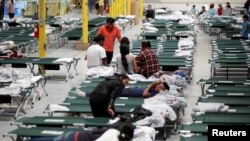President Donald Trump on Monday tweeted that Immigration and Customs Enforcement “will begin the process of removing the millions of illegal aliens who have illicitly found their way into the United States” next week.
This isn’t the first time Trump has threatened to deport undocumented immigrants on a massive scale. Shortly after his inauguration during an interview with CBS News, he pledged to deport up to 3 million undocumented immigrants with “criminal records.” That didn’t happen then, and the reality on the ground is far more complicated now.
Can this really happen? How soon? And what would the removal involve? VOA provides some perspective.
What is ICE’s record of arrests and deportation?
There are an estimated 11.3 million undocumented immigrants currently residing in the United States, according to the Migration Policy Institute.
In fiscal 2018, ICE's Enforcement and Removal Operations (ERO) made 158,581 arrests while recording 256,085 ICE removals — an increase from both 2016 and 2017, but a sharp decrease from its peak of 409,849 removals in fiscal 2012. However, interior removals only make up a fraction of those figures. Many more are nonresidents who were removed after crossing the border.
Why is Trump's threat questionable?
Even if the president attempted to stay true to his word, there are not nearly enough ICE agents available to conduct an operation of this scale. As the Washington Post reported June 17, such a plan would require weeks of planning, along with hundreds, if not thousands, of agents and law enforcement personnel, who have been spread thin because of budget limitations and concentrated efforts along the U.S.-Mexico border.
In a call with reporters Wednesday, ICE Acting Director Mark Morgan said the agency’s system is overloaded. He anticipates around 1 million additional entries through the U.S. southwest border this year, some three-quarters of them released into the interior of the United States. Since Dec. 1, more than 207,000 family members have been released into the interior of the country, according to Morgan.
Adding to the miscommunication, ICE — which normally does not publicize its operations in advance — appeared to be caught off-guard by the announcement.
WATCH: Trump Warns Of Mass Deportations at Campaign Rally
Furthermore, there is due process in the United States, and immigration courts are already extremely backlogged. Earlier this month, NPR reported that the backlog has grown to nearly 900,000 cases; the American Bar Association said the courts were "on the brink of collapse."
Beyond the threatened crackdown on undocumented migrants who have exhausted their deportation appeals, the U.S. has demanded concessions from Mexico and Central American countries to prevent people from illegally crossing the border into the United States.
Trump claimed Monday that Guatemala was “getting ready to sign” an agreement that would force migrants who flee persecution in El Salvador and Honduras to request asylum in Guatemala instead of Mexico or the United States, confirming VOA reporting from last week.
A U.S. delegation traveled to Guatemala last week to seek approval for the “safe third country” protocol.
What is a safe third country agreement?
A bilateral safe third country agreement with Guatemala would prevent asylum-seekers from Honduras and El Salvador from applying for asylum in the U.S.
The U.S. currently only has one such agreement in place, and that’s with Canada. With few exceptions, such as unaccompanied minors, refugee claimants are “required to request refugee protection in the first safe country they arrive in,” namely the U.S. or Canada. Both are deemed “safe.”
How would that work if the U.S. and Guatemala signed a deal?
Guatemalan nationals account for the second-highest number of asylum-seekers in the U.S., after El Salvador. Gang-related violence in Guatemala remains prevalent.
But if a similar safe third country agreement were reached with Guatemala, nationals from neighboring El Salvador and Honduras hoping to reach the U.S. would instead be forced to seek asylum in Guatemala, because of its geographic placement as a gateway to both Mexico and the U.S to its north. Under the proposed draft agreement, if a Central American were to continue north past Guatemala, reaching the United States, U.S. immigration authorities would send them back to Guatemala.
The State Department decided to cut millions of dollars in foreign aid to Central America on Monday. Is that a factor in a U.S.-Guatemala deal?
No deal appears imminent, according to Guatemala’s interior minister, Enrique Degenhart. On Tuesday, Degenhart told reporters that while there was no agreement yet, “(Guatemala is) in discussions to find a measure that suits both countries,” adding, “the fact that a country like the U.S. sees us as a safe country in principle is hugely positive.”
In response to VOA questions on the status of negotiations, a U.S. State Department spokesperson said, “Our teams are looking at many options and working to ensure we get results.”
What has been the international response?
Guatemala aside, the Mexican government has shown hesitance to sign its own “safe third country” deal with the U.S., but has signaled a willingness to join a larger regional asylum pact with countries such as Guatemala, Panama and Brazil if other efforts to curb the current migration crisis are not met. A regional pact would mean that the burden to process asylum claims would be shared between the countries involved, based on where an asylum-seeker first steps foot.






